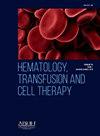A HEMATOLOGICAL CHAMELEON: THE TRANSITION FROM MDS TO NON-SECRETORY MULTIPLE MYELOMA AND BACK – UNRAVELİNG DIAGNOSTIC COMPLEXITIES AND ADAPTING THERAPEUTIC PATHWAYS
IF 1.8
Q3 HEMATOLOGY
引用次数: 0
Abstract
Objective
The interplay between myelodysplastic syndrome (MDS) and non-secretory multiple myeloma (MM) can confound even seasoned hematologists, particularly when these conditions shift over time. This case presents a remarkable instance of a patient transitioning from MDS to non-secretory MM and then reverting back to MDS, underscoring the need for meticulous monitoring and adaptable treatment strategies when dealing with complex hematological landscapes.
Case Presentation
An 82-year-old patient initially sought care for severe anemia, leading to a diagnosis of MDS based on bone marrow findings. At this point, no signs of MM were present. However, later investigations—specifically urine immunofixation—suggested the emergence of non-secretory MM, which was confirmed through a second bone marrow biopsy.
The patient began treatment with Velcade, Revlimid, and Dexamethasone (VRD), showing marked improvement in anemia. Yet, given the patient's age and frailty, hematopoietic stem cell transplantation (HSCT) was not considered viable. As treatment progressed, the regimen evolved to ixazomib, lenalidomide, and dexamethasone, achieving remission for several years.
Despite this stability, a resurgence of anemia signaled a reversion to MDS. A fresh treatment strategy was introduced, combining azacitidine, low-dose lenalidomide, and erythropoietin, aimed at maintaining functionality and quality of life without aggressive interventions.
Discussion
This case encapsulates the volatile nature of hematologic disorders, illustrating how diseases like MDS and non-secretory MM can morph and evolve. It emphasizes the importance of adaptive management, especially in elderly patients, where rigid treatment paradigms may fall short. The use of lenalidomide throughout the patient's journey reflects its dual utility in both plasma cell and myeloid disorders, while also sparking questions about whether prolonged exposure could influence secondary disease development.
Conclusion
The patient's journey through MDS, MM, and back again underscores the critical need for dynamic reassessment, vigilance, and personalized care. This case exemplifies the blurred boundaries between plasma cell dyscrasias and myeloid neoplasms, raising thought-provoking questions about disease progression and therapeutic strategies. In navigating these complexities, clinicians are reminded of the importance of flexible, patient-centered approaches in managing intricate hematological disorders.
求助全文
约1分钟内获得全文
求助全文
来源期刊

Hematology, Transfusion and Cell Therapy
Multiple-
CiteScore
2.40
自引率
4.80%
发文量
1419
审稿时长
30 weeks
 求助内容:
求助内容: 应助结果提醒方式:
应助结果提醒方式:


